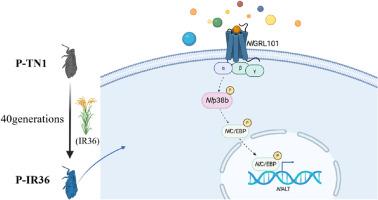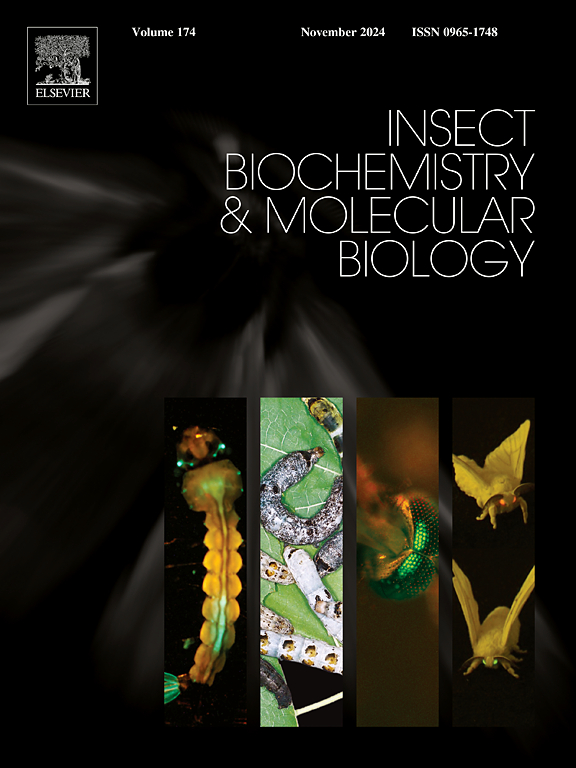Identification of a vital transcription factor of the alanine aminotransferase in the brown planthopper and its upstream regulatory pathways
IF 3.2
2区 农林科学
Q2 BIOCHEMISTRY & MOLECULAR BIOLOGY
引用次数: 0
Abstract
The brown planthopper (Nilaparvata lugens) is an important insect pest of rice, and can rapidly adapt to insect-resistant rice varieties. In our previous studies, alanine aminotransferase in N. lugens (NlALT) was found to play an important role in the adaptation of the brown planthopper to resistant rice IR36. Here, we further identified CCAAT/enhancer binding protein (NlC/EBP) as a vital transcription factor of NlALT. Nlp38b in the MAPKs pathway regulated the expression of NlALT by influencing the phosphorylation level of NlC/EBP. In addition, we found that NlGRL101, a G protein-coupled receptor (GPCR), was significantly higher expressed in the N. lugens population adapted to IR36 (P-IR36). After knockdown of NlGRL101 through RNAi in P-IR36 population, lower expressions of Nlp38b and NlC/EBP, along with reduced phosphorylation levels of Nlp38b and NlC/EBP were observed; moreover, NlALT activity and honeydew amount were decreased by 15.68% and 76.08%, respectively. These results indicated that insect-resistant rice IR36 induced expression of NlGRL101, which enhanced expression of NlALT through Nlp38b and NlC/EBP. These findings are helpful for better understanding of insect adaptation to resistant crop varieties.

鉴定褐飞虱丙氨酸氨基转移酶的一个重要转录因子及其上游调控途径。
褐飞虱(Nilaparvata lugens)是水稻的重要害虫,能迅速适应抗虫水稻品种。我们之前的研究发现,褐飞虱体内的丙氨酸氨基转移酶(NlALT)在褐飞虱适应抗性水稻 IR36 的过程中发挥了重要作用。在此,我们进一步确定了 CCAAT/增强子结合蛋白(NlC/EBP)是 NlALT 的一个重要转录因子。MAPKs通路中的Nlp38b通过影响NlC/EBP的磷酸化水平来调控NlALT的表达。此外,我们还发现,在适应IR36(P-IR36)的N. lugens群体中,G蛋白偶联受体(GPCR)NlGRL101的表达量明显较高。在 P-IR36 群体中通过 RNAi 敲除 NlGRL101 后,观察到 Nlp38b 和 NlC/EBP 的表达量降低,Nlp38b 和 NlC/EBP 的磷酸化水平降低;此外,NlALT 活性和蜜露量分别降低了 15.68% 和 76.08%。这些结果表明,抗虫水稻IR36诱导了NlGRL101的表达,而NlGRL101通过Nlp38b和NlC/EBP增强了NlALT的表达。这些发现有助于更好地了解昆虫对抗性作物品种的适应性。
本文章由计算机程序翻译,如有差异,请以英文原文为准。
求助全文
约1分钟内获得全文
求助全文
来源期刊
CiteScore
7.40
自引率
5.30%
发文量
105
审稿时长
40 days
期刊介绍:
This international journal publishes original contributions and mini-reviews in the fields of insect biochemistry and insect molecular biology. Main areas of interest are neurochemistry, hormone and pheromone biochemistry, enzymes and metabolism, hormone action and gene regulation, gene characterization and structure, pharmacology, immunology and cell and tissue culture. Papers on the biochemistry and molecular biology of other groups of arthropods are published if of general interest to the readership. Technique papers will be considered for publication if they significantly advance the field of insect biochemistry and molecular biology in the opinion of the Editors and Editorial Board.

 求助内容:
求助内容: 应助结果提醒方式:
应助结果提醒方式:


